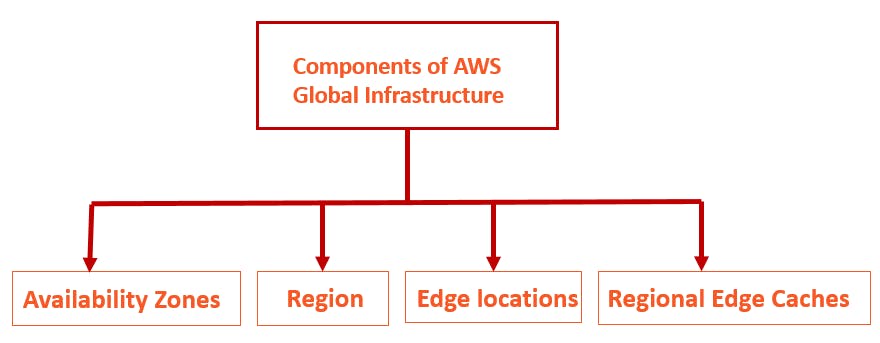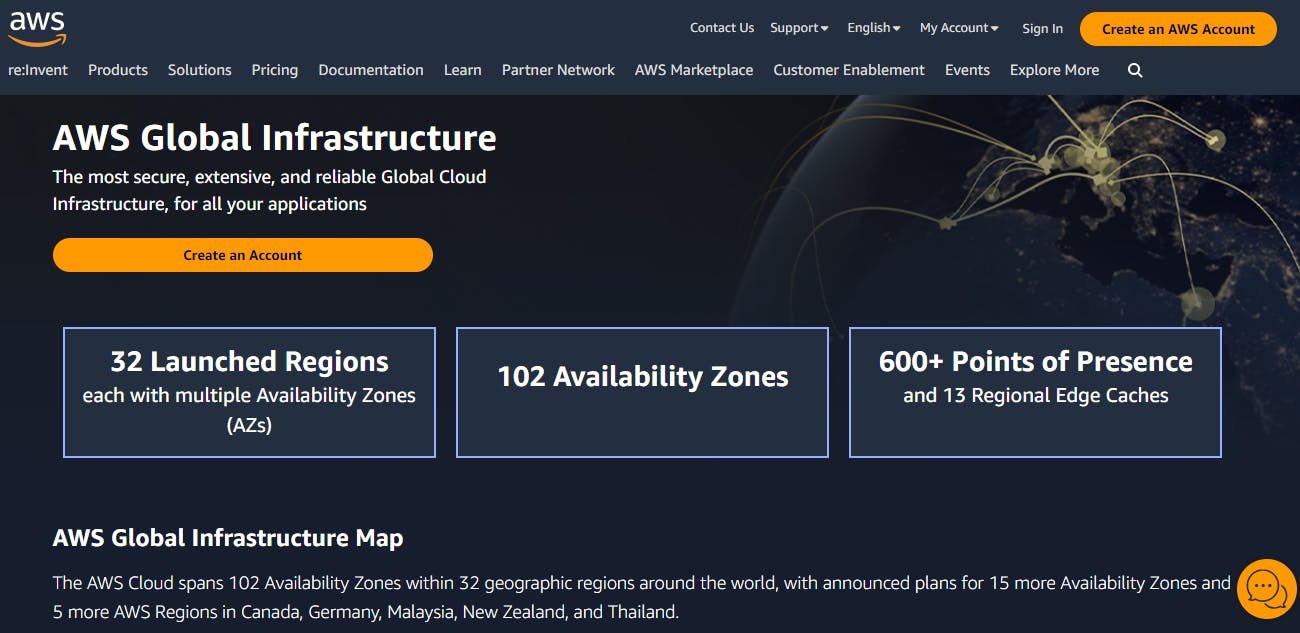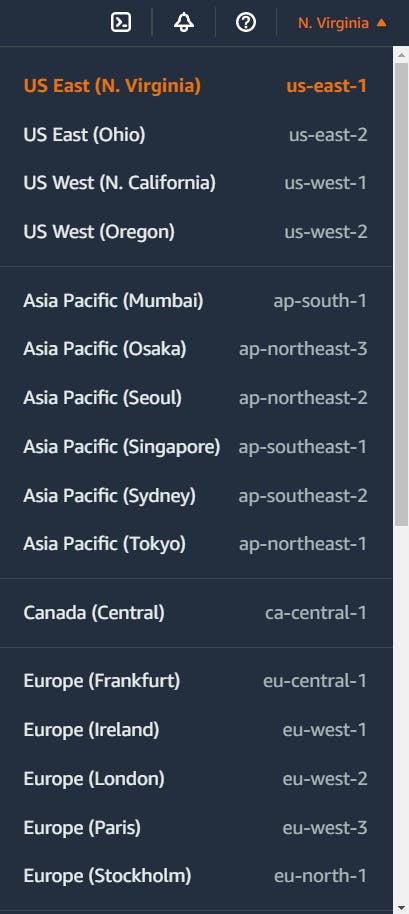🔶 AWS Global Infrastructure
Amazon Web Services (AWS) offers cloud computing services to businesses and individuals worldwide. One of the key features of AWS is its extensive global infrastructure, which comprises different regions and availability zones. AWS Regions are separate geographic locations where AWS resources are available, and each region is made up of multiple data centers.
AWS Global Infrastructure in the form of Region and Availability Zone.
The AWS Cloud spans 102 Availability Zones within 32 geographic regions around the world, with announced plans for 15 more Availability Zones and 5 more AWS Regions in Canada, Israel, Malaysia, New Zealand, and Thailand.
The following diagram shows the Components of the AWS Global Infrastructure.

🔶AWS Regions
A Region is a physical location in the world where we have multiple Availability Zones.
Amazon Web Services (AWS) is a cloud computing platform that offers various services for businesses and individuals to store, manage, and access data and applications on the Internet. One of the key features of AWS is its global infrastructure with data centers located in different parts of the world. These data centers are grouped into regions, which are geographic locations that contain multiple Availability Zones (AZs).

Each region is designed to provide low latency, high availability, and fault tolerance to AWS customers. AWS Regions are independent and isolated geographic areas that are connected by a highly available, low-latency network.
There are currently 32 regions globally, with more planned to be added in the future.
🔗Please check Current regions and Availability Zones (AZs)
Each region is identified by a unique code name, such as us-east-1, ap-southeast-2, and eu-central-1. The regions are strategically located to provide customers with the best possible performance and compliance with local regulations.
AWS Regions are further divided into Availability Zones (AZs), which are physically separate data centers within a region. Each AZ is designed to be isolated from failures in other AZs, providing customers with high availability and fault tolerance. AZs are connected by low-latency links, allowing customers to replicate data and applications across AZs for redundancy and disaster recovery purposes.
AWS also offers a Global Accelerator service that routes traffic to the optimal AWS endpoint based on latency, health, and routing policies, further enhancing the performance and availability of applications running on AWS.
💡 Example:
A small business in the United States is experiencing steady growth and wants to expand its online presence to reach more customers. They decided to use AWS to host their e-commerce website and chose the us-east-1 region as their primary region for storing and managing their customer data and website files. They also set up a backup copy of their data in the us-west-2 region, in case of any catastrophic event that may affect the us-east-1 region.
🔶What are AWS Regions?
One of the key features of AWS is its global infrastructure, which consists of physical data centers located in different regions around the world. These regions are designed to provide low latency, high availability, and compliance with local data privacy laws.

This article will introduce you to AWS Regions and how they work. AWS Regions are locations where Amazon has data centers hosting its cloud services.
Currently, AWS operates in 32 regions around the world, with plans to expand further. Each region is a separate geographic area with multiple data centers, connected by high-speed networks. The data centers within each region are isolated from each other and are designed to operate independently, ensuring that any issues in one region do not affect the others.
Each AWS Region has its name, such as US East (N. Virginia), EU (Ireland), Asia Pacific (Sydney), etc. Depending on their needs and requirements, customers can choose to launch their resources in any region they want.
For example, if a company has customers in Europe, they may choose to host their application in the EU (Ireland) region for better performance and compliance with EU data privacy laws. Similarly, if they have customers in Asia, they may choose to host their application in the Asia Pacific (Singapore) region.
🔶Importance of Choosing the Right Region
The importance of choosing the right region cannot be overstated. Each AWS region is designed to provide optimal performance and reliability for specific geographic areas.
For example, if you have customers in the United States, you should choose an AWS region in North America for better performance and lower latency. Similarly, if you have customers in Europe, you should choose an AWS region in Europe.

By choosing the right region, you can ensure that your applications and services are delivered with the best possible performance and reliability. Another important factor to consider when choosing an AWS region is compliance with local regulations.
AWS has designed its regions to comply with local laws and regulations, such as data privacy laws, data residency requirements, and security standards. By choosing the right region, you can ensure that your data is stored and processed in compliance with local regulations.
This is particularly important for businesses that operate in highly regulated industries, such as healthcare, finance, and government. In conclusion, choosing the right AWS region is critical for businesses that want to take advantage of the benefits of cloud computing.
By selecting the right region, businesses can ensure that their applications and services are delivered with the best possible performance and reliability while complying with local regulations.
AWS provides a wide range of regions to choose from, so businesses should take the time to evaluate their needs and select the region that best meets their requirements.
🔶Factors to Consider when Choosing a Region
As a student who is interested in learning about AWS regions, it is important to understand the factors that are considered when choosing a region. AWS is a cloud computing platform that provides a range of services to businesses and individuals around the world.
One of the key features of AWS is its ability to offer services from different regions. Each region has its own set of data centers, which are distributed across multiple availability zones. When deciding which AWS region to use for your business, there are several factors to consider.
One of the most important factors to consider when choosing an AWS region is the proximity of the region to your business. The closer the region is to your business, the faster your applications will run, and the lower your latency will be. Latency is the time it takes for data to travel from one point to another, and it is a critical factor in determining the performance of your applications.
If you have customers or users in different parts of the world, you may want to consider using multiple regions to ensure that your applications are performing well for everyone. Another factor to consider when choosing an AWS region is the cost of the services. AWS prices its services differently in different regions, and the cost can vary significantly depending on the region you choose.
For example, the cost of running a virtual server in the US East region may be different than the cost of running the same server in the EU West region. It is important to compare the pricing of different regions to determine which one will provide the best value for your business.
Lastly, it is important to consider the security and compliance requirements when choosing an AWS region. Each region has its own set of regulations and compliance standards that must be met. It is essential to ensure that the region you choose meets all the security and compliance requirements for your business.
This is particularly important if you are dealing with sensitive data. By considering these factors, you can choose the right AWS region that meets the needs of your business.
Following these best practices will help you to make the most of AWS Regions and ensure that your applications are highly available, performant, and cost-effective.
🔸 Firstly, it is important to choose the right region for your workload. This means selecting a region that is geographically close to your users, to reduce latency and improve performance.
It is also important to consider the regulatory requirements of your industry and ensure that the region you choose complies with these regulations.
🔸 Secondly, it is best practice to use multiple regions to ensure high availability and disaster recovery. This means spreading your workload across different regions so that if one region experiences an outage, your application can still function in another region.
🔸Lastly, it is important to monitor and optimize your use of AWS Regions. This means regularly reviewing your workload and ensuring that you are using the right regions for your needs.
🔸 You should also ensure that you are not over-provisioning resources, as this can lead to unnecessary costs. By using AWS tools such as CloudWatch and AWS Trusted Advisor, you can monitor your usage and optimize your resources for cost-effectiveness.
🎉 Congratulations
In conclusion, AWS Regions are locations where Amazon has data centers hosting its cloud services. AWS operates in 32 regions around the world, each with multiple data centers connected by high-speed networks. Depending on their needs and requirements, customers can choose to launch their resources in any region they want. AWS Regions are designed to provide low latency, high availability, and compliance with local data privacy laws.
🔗Please check Current regions and Availability Zones (AZs)
If you enjoyed this article please like it and share it with your friends and colleagues!
Thank you for reading🤓
